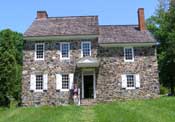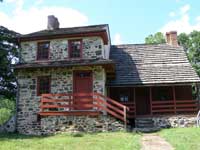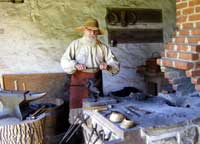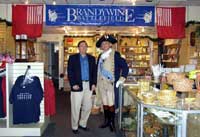Brandywine - Pennsylvania Historic Site

THE BATTLE OF BRANDYWINE
In 1777, British General Sir William Howe was given the task of attacking Philadelphia. He sailed up the Chesapeake Bay to a place called Head of Elk (present day Elkton, Maryland), then marched northward to the outskirts of Kennett Square, Pa. George Washington stationed his troops along the length of Brandywine Creek in and around Chadds Ford. On September 11, 1777, the two armies faced off with a total of 30,000 soldiers and militia in what became the largest land battle in America up until the Civil War.
The first shots were fired in the area of the Old Kennett Meeting House. From the west, 5,000 German troops under Knyphausen overwhelmed Maxwell’s brigade while sustaining heavy casualties. Washington had received two conflicting reports: one that said the British were attacking with their main force from the north- and a later one which contradicted the first report. Being cautious, Washington decided not to make any substantial changes in his positions. Yet, if he’d attacked Knyphausen, he might have achieved a temporary tactical victory, with the chance to later flank Howe.
Howe was the one who flanked Washington. He moved the bulk of his Army to the north, then crossed the creek to the southeast approaching the Birmingham Meeting House. Howe took positions on and around Osborne’s Hill. The two armies clashed across the hillsides several times, the heaviest fighting raging around the Meeting House. By mid-afternoon, Generals Greene, Wayne and Sullivan were actively engaged in hard fought skirmishes with the British, as was the 20-year old Marquis de Lafayette, who was wounded not far from the cemetery which today bears his name. By late in the day Washington started a retreat. Casimir Pulaski supplied a strong rear guard with his horse brigade and was later given the moniker “Father of the U.S. Cavalry”.
Our undersupplied troops went toe-to-toe with the most powerful military in the world and survived to fight another day. Two future Presidents fought here: George Washington and James Monroe, as did John Marshall, later a Chief Justice of the United States Supreme Court and Alexander Hamilton, our first Secretary of the Treasury. The future of the United States of America could have been altered during this battle. British Captain Patrick Ferguson had developed a breech-loading rifle that was far superior in both range and accuracy compared to the muskets used by Washington’s troops. During the conflict, Ferguson noted that he had a high-ranking rebel officer in his sights- well within range of his gun. Ferguson took aim, but could “not fire at the back of an unoffending individual, who was acquitting himself very coolly of his duty… so I let him alone.” That man was later identified by some historians as General George Washington.
The Brandywine Battlefield Park covers 52 acres and contains two important buildings from the revolutionary era - the Ring house where Washington set up his headquarters before the battle and the Gilpin house, where Lafayette is said to have stayed. There is also an amazing giant Sycamore tree from the revolutionary era still growing by the Gilpin house. The visitor center has an excellent museum shop and offers driving tour maps of the battle including existing battle sites such as the Birmingham Meeting House. More about the Brandywine Battlefield...



